One of my favorite activities to do in winter is snowshoeing. Time to give the MSR Lightning Ascent snowshoes a good shakedown. Enjoy the review!
- Size: 22”, 25” women, 22”, 25”, 30” men
- Weight: from 1.74 kg (3 lbs 13 oz)
- Price: € 370,00 / $ 349,95
The last couple of years snow has been a rarity in my home country The Netherlands. Since the pandemic I also did not have that much of opportunities to travel but has changed with restrictions being a bit less strict and traveling made easier. So… the first opportunity I had, I took and went to Switzerland to test the MSR Lightning Ascent snowshoes.
MSR Lightning Ascent: materials
I have always liked the technical approach that MSR takes towards their snowshoe construction. The MSR Lightning Ascent snowshoes are no different in that respect. They are made out of a combination of a 7075-T6 aluminum frame, steel for the teeth at the front of the foot and the crossmembers, a TPU-coated nylon deck and ‘plasticrubbery’ parts for the binding. What type these ‘plasticrubbery’ parts exactly are, MSR does not specify.
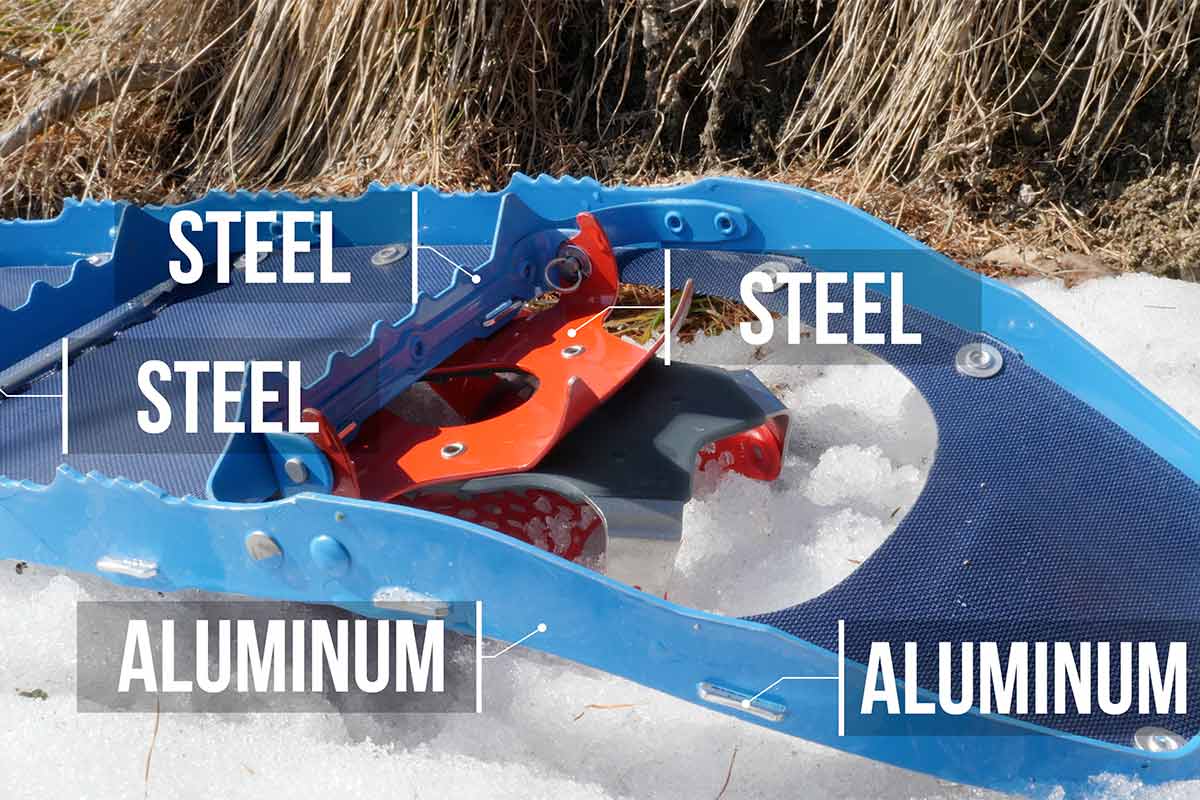
Size and weight
Like shoes, snowshoes come in sizes and in the case of the MSR Lightning Ascent there is also a ladies version available: the Women’s MSR Lightning Ascent. And since ladies are first:
The Women’s MSR Lightning Ascent is available in sizes 22 Inch and 25 Inch and they weigh 1.74 kg (3 lbs 13 oz) and 1.81 kg (4 lbs 1 oz). The 22 Inch is for ladies up to 80 kg (180 lbs) and the 25 Inch for those between 54 and 95 kg (120-210 lbs). Both fit shoesizes 36-43 (6W-12W). For those who need a bit more support extra tails can be added to the Women’s MSR Lightning Ascent increasing the load to 109 kg (240 lbs) for the 22 Inch and 123 kg (270 lbs) for the 25 Inch.
The Men’s MSR Lightning Ascent is available in sizes 22, 25 and 30 Inch and they weigh 1.87 kg (4 lbs 3 oz), 1.95 kg (4 lbs 5 oz) and 2.22 kg (4 lbs 15 oz). The 22 Inch go’s up to 80 kg (180 lbs), the 25 Inch take 54-100+ kg (120-220 lbs) and the 30 Inch are for men between 68-127+ kg (150-280+ lbs). All fit shoesizes 39-48 (6M-14M). For those who need a bit more support extra tails can be added to the MSR Lightning Ascent increasing the load to 114 kg (250 lbs) for the 22 Inch, 127 kg (280 lbs) for the 25 Inch and 82-136 kg (180-300 lbs) for the 30 Inch.
The big difference in build between the men’s and women’s snowshoes is that the ladies’ snowshoes are 2 cm less wide: 18 cm (7.25 Inch) or 20 cm (8 Inch).
Paragon binding: easy does it
The MSR Lightning Ascent features the Paragon binding. This binding is a sort of mesh cup that you put your shoes in. On the sides there are two straps and there is another on the back. Getting the shoes in – I use a quite heavy The North Face shoe for snowshoeing – is easy. Fixation of the shoes is done by locking the straps. I prefer to do the back strap first and the side one next. In this way my shoe gets pushed in the cup and that gives a very solid end result. One side strap I only loosened and fasted only the first time; after this no changes needed to be made.
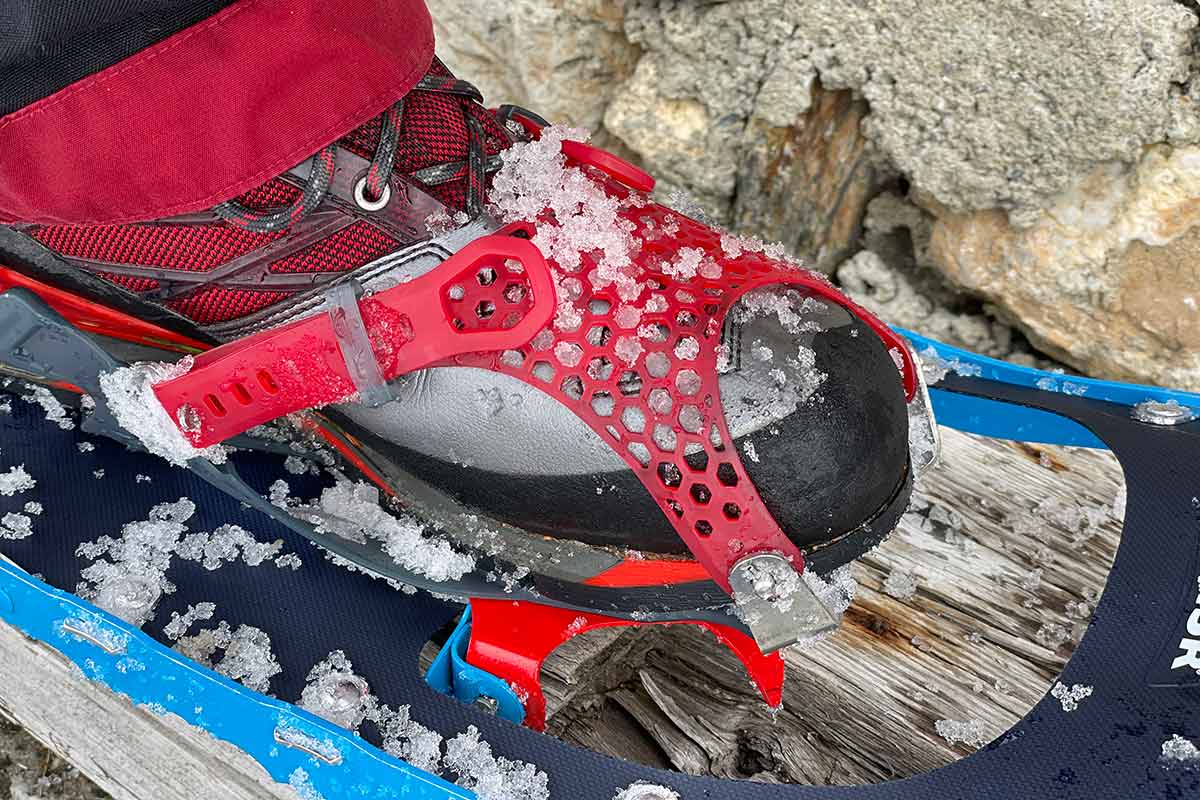
Adjusting during a hike is childsplay; the Paragon bings straps stay flexible during freezing conditions and are a pleasure to use. The straps have good loops so you never have loose ends dangling away. One last remark on the bindings: they can be removed easily without having to use tools. This is good for cleaning, maintenance or replacement.
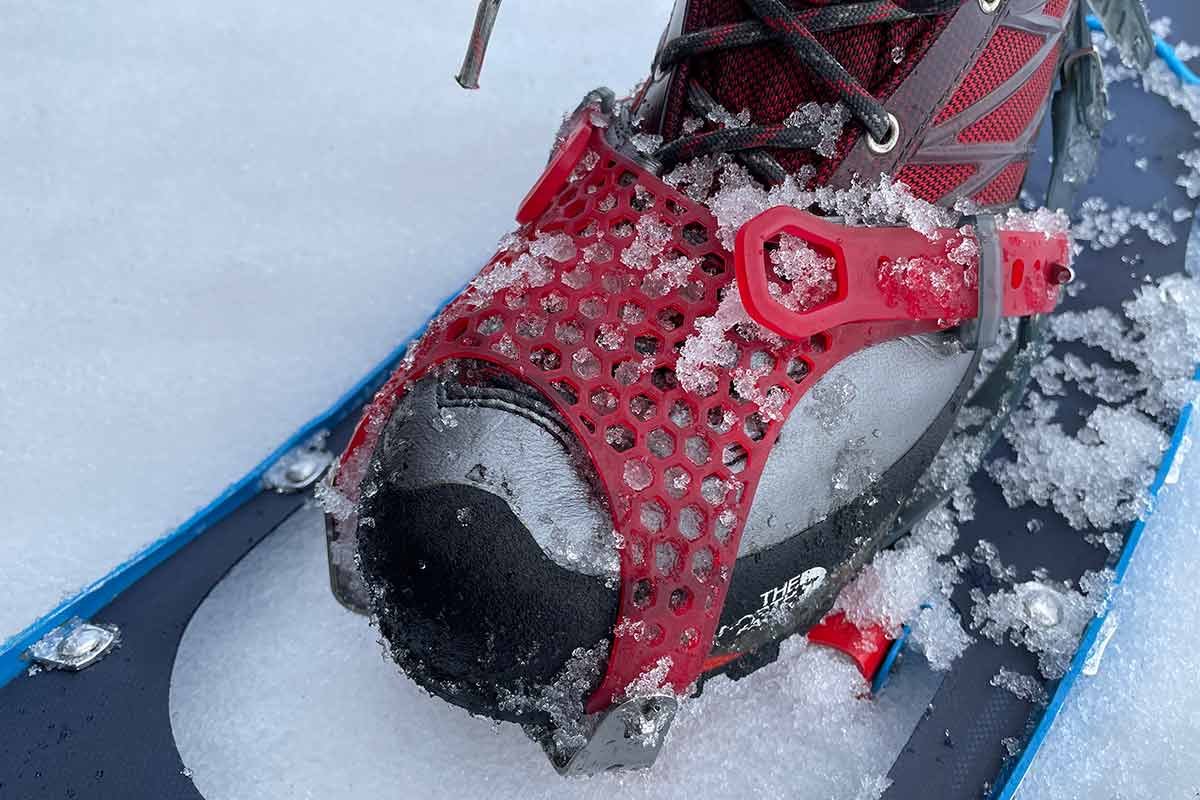
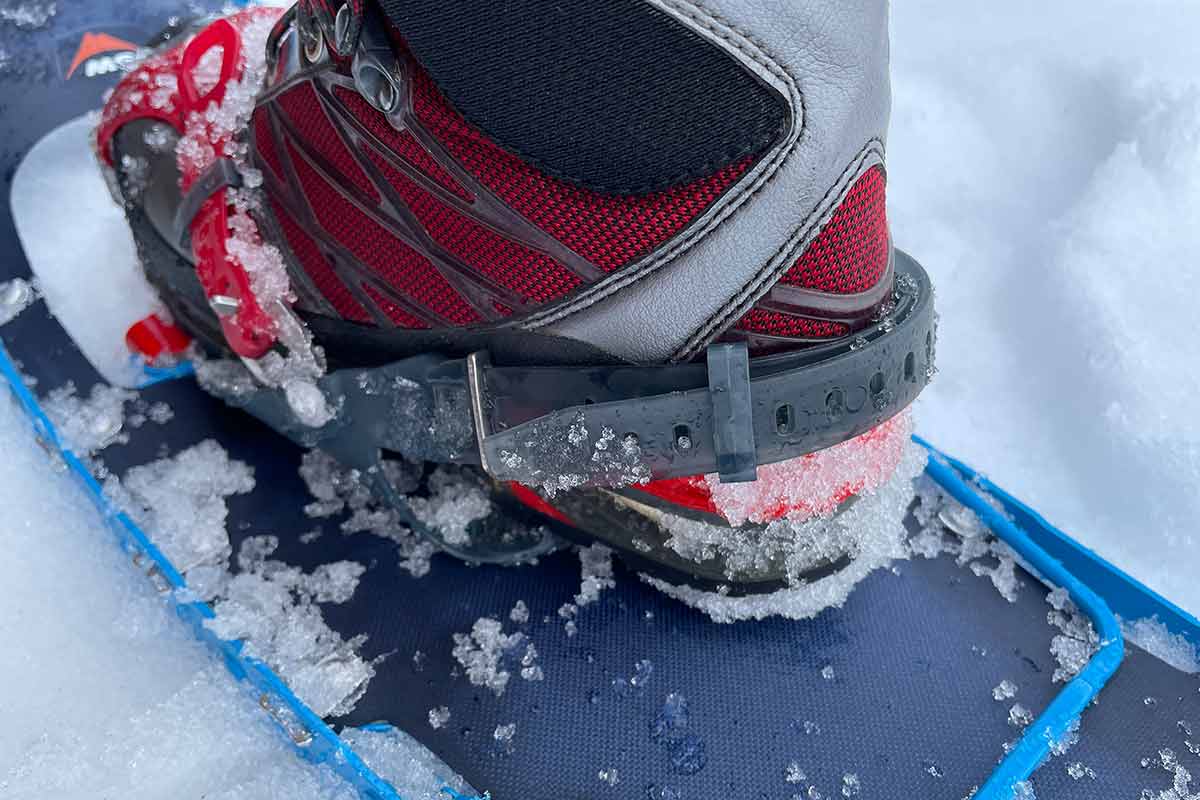
Left and right shoe
Like with a lot of snowshoes, the MSR Lightning Ascent has a Right and a Left shoe. It is quite clearly marked on the shoe at the point where the outsole of the shoe rests. Only when snow has built up here a little it is hard to see and a mark on the tip near the MSR logo would be a bit more convenient. The difference between the Left and the Right shoe is very hard to see and mostly also hard to notice in practice. I made the mistake many times to use left right and right left. But you start noticing it after a while; using them the wrong way around the snowshoes just bump a bit more into each other than when using them correctly.
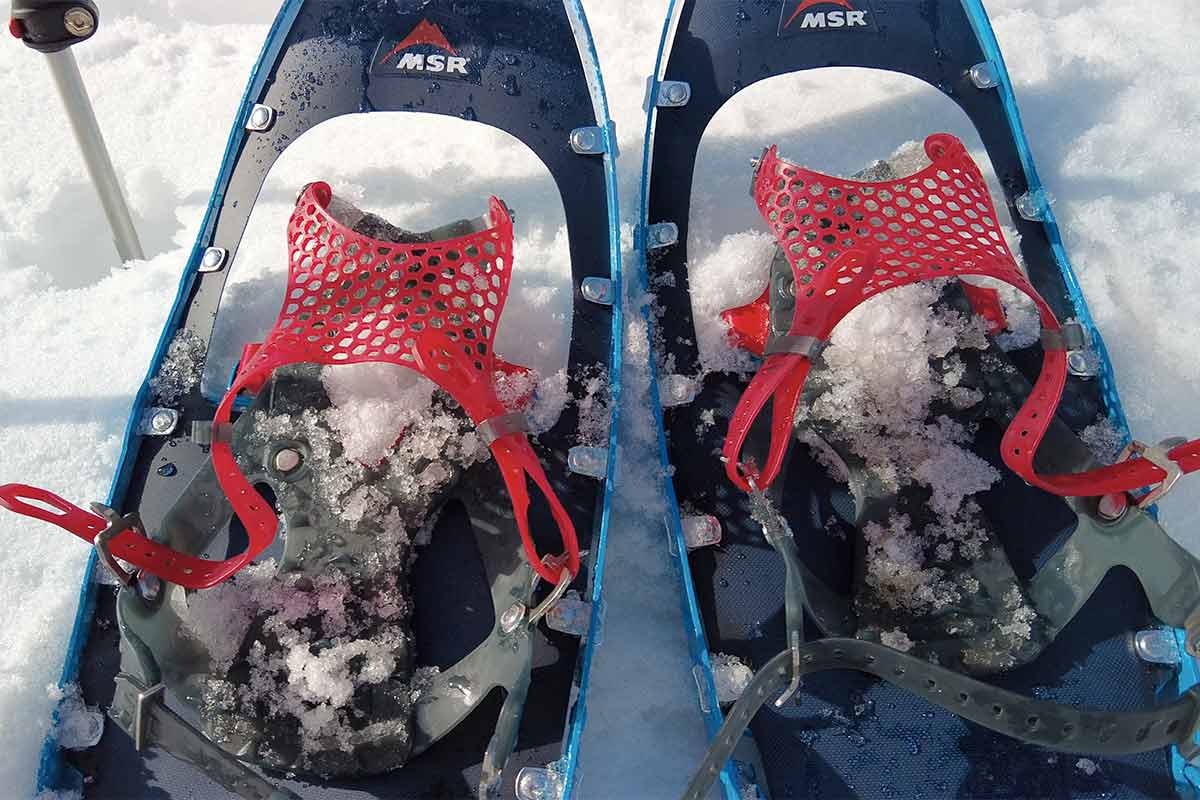
Snowshoeing in practise
I have used the MSR snowshoes in a lot of different snow conditions and they have proven very good allround snowshoes.
The pivoting point that connects the snowshoe and binding works well for me. Walking stays natural and I hardly ever experienced any limitations to my freedom of movement. Not on more ‘level’ slopes nor on steep slopes climbing and descending.
In deep powder snow they have a huge floating potential* – I weigh 63 kg – and I hardly sink in the snow too deep making a hike a pleasure and not a struggle. Of course, exceptions are always there and I went waist deep occasionally.
On more iced up snow on more level slopes the aluminum teeth from the frame provide enough grip not to slip but the steel teeth underneath the ball of the foot help a great deal here.
Also climbing a steep slope is not a problem for the Lightning Ascent. Again the steel teeth provide good climbing grip capabilities.
*It is possible to increase the floating capacity by adding the Lightning Modular Flotation Tails to the snowshoes. These tails clip on to the back of the snowshoes and extend them by 13 cm (5 inches).
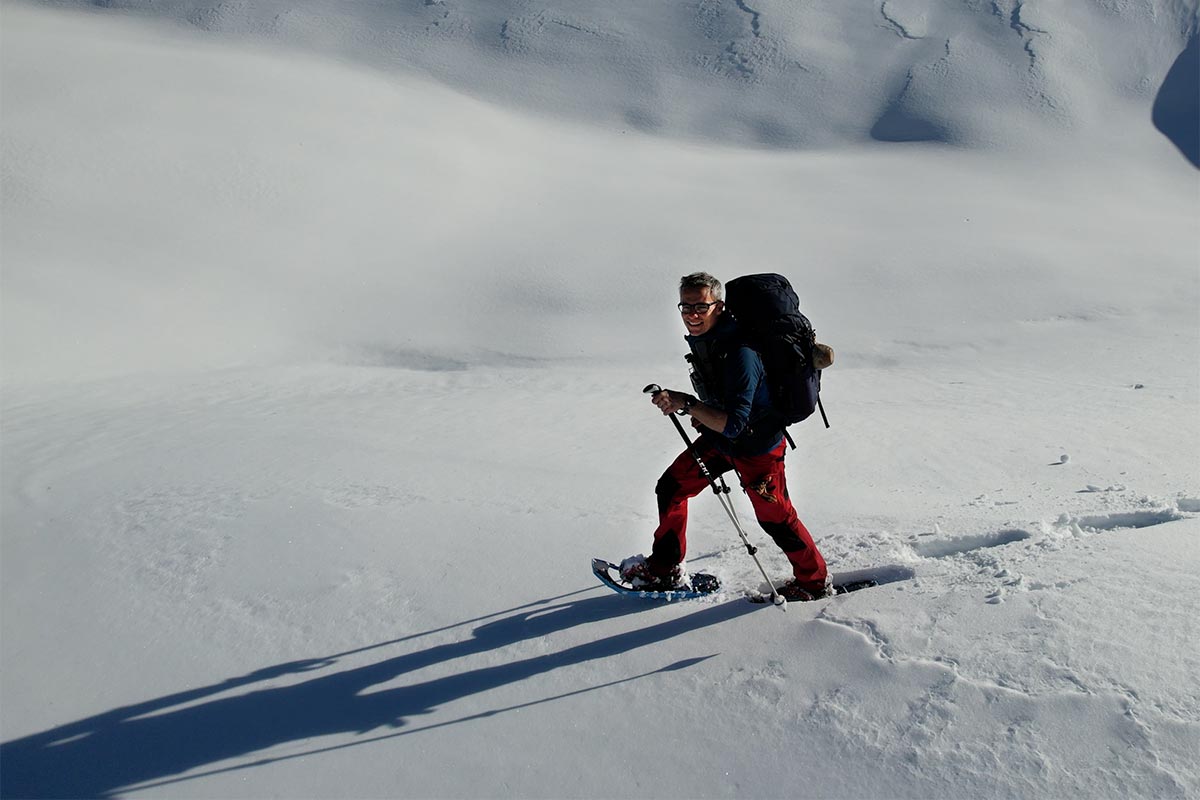
Where things get different…
Things get a bit different when traversing on steeper slopes. When the snow is how we like snow the best; no problems whatsoever in hiking a slope parallel. The frame digs in nicely. But on iced up slopes I didn’t find the side teeth on the aluminum frame to be grippy enough and I slided sideways too much to my liking.
Walking up-hill is made easy with the so-called ‘Ergo Televators’. This is a U-shaped bar that can be flipped up with the result that the heel of the shoe rests on this when hiking up on steeper hills. The result is a more ‘horizontal’ shoe and this results in less fatigue. The ease of use of this U-shaped bar is super. I only needed one of my poles to flip it.

Flat package
A snowshoe hike doesn’t always start immediately; sometimes you have to walk with the snowshoes on your backpack to the snow. I like that the Lightning Ascent snowshoes pack flat together. On the back of my backpack it makes the backpack still very compact. This is a benefit if you use a cable car for example to get to the start of your hike. It also means that the snowshoes are close to your back and not influencing – or disrupting – the center of gravity too much and that is safer.

Verdict
I have been testing the MSR Lightning Ascent snowshoes in the Swiss Alps. They have been tested in a wide variety of snow, snow conditions and on flat and very steep slopes. A very representative mix to get a good opinion on them. Overall I do like them. They pack flat, are compact to carry and the weight is fine. The Paragon binding is super in every aspect. Comfortable, easy to use and it remains flexible in freezing circumstances. It is also user friendly when gloved up.
The ‘Ergo Televators’ are easy to use and prove comfortable going up steep slopes. In general the snowshoes perform excellent 90% of the time and the aluminum frame and steel teeth under the ball off the foot provide good grip except when traversing on more icy slopes. The price of the MSR Lightning Ascent is € 370,00 / $ 349,95 and that is pretty steep. I rate the MSR Lightning Ascent at 8.9 points out of 10.
Information
International: www.msrgear.com
For the Dutch: cjagencies-baarn.nl
